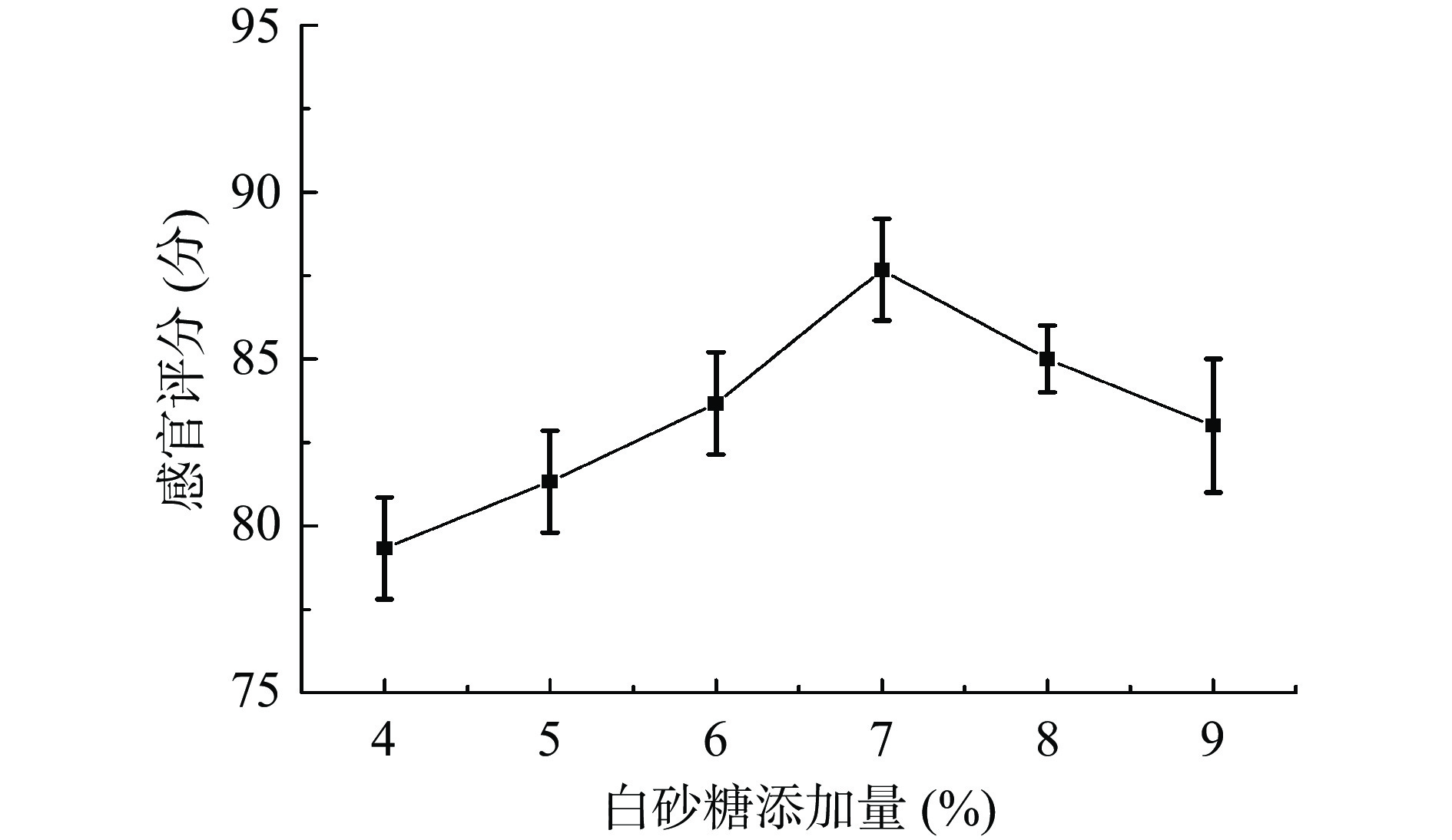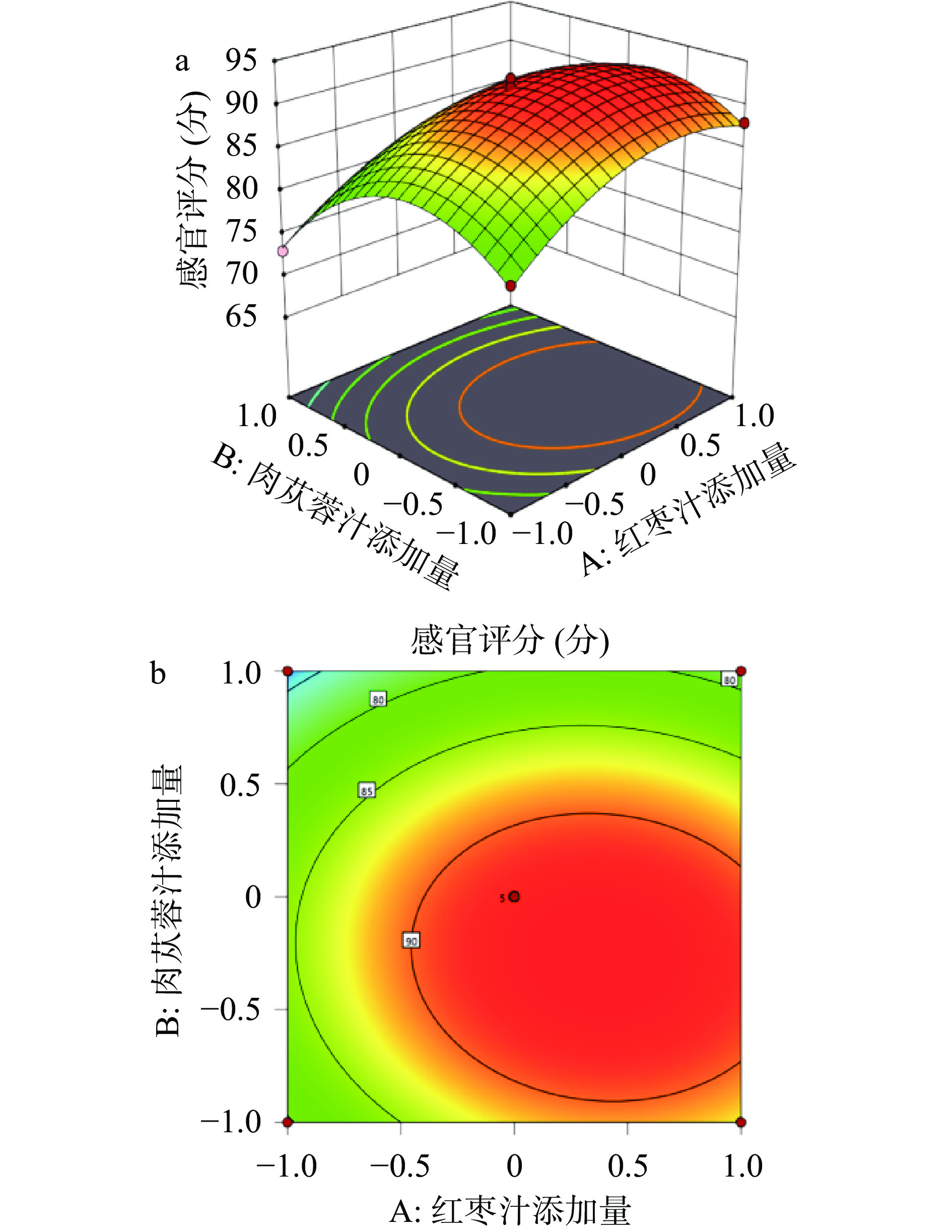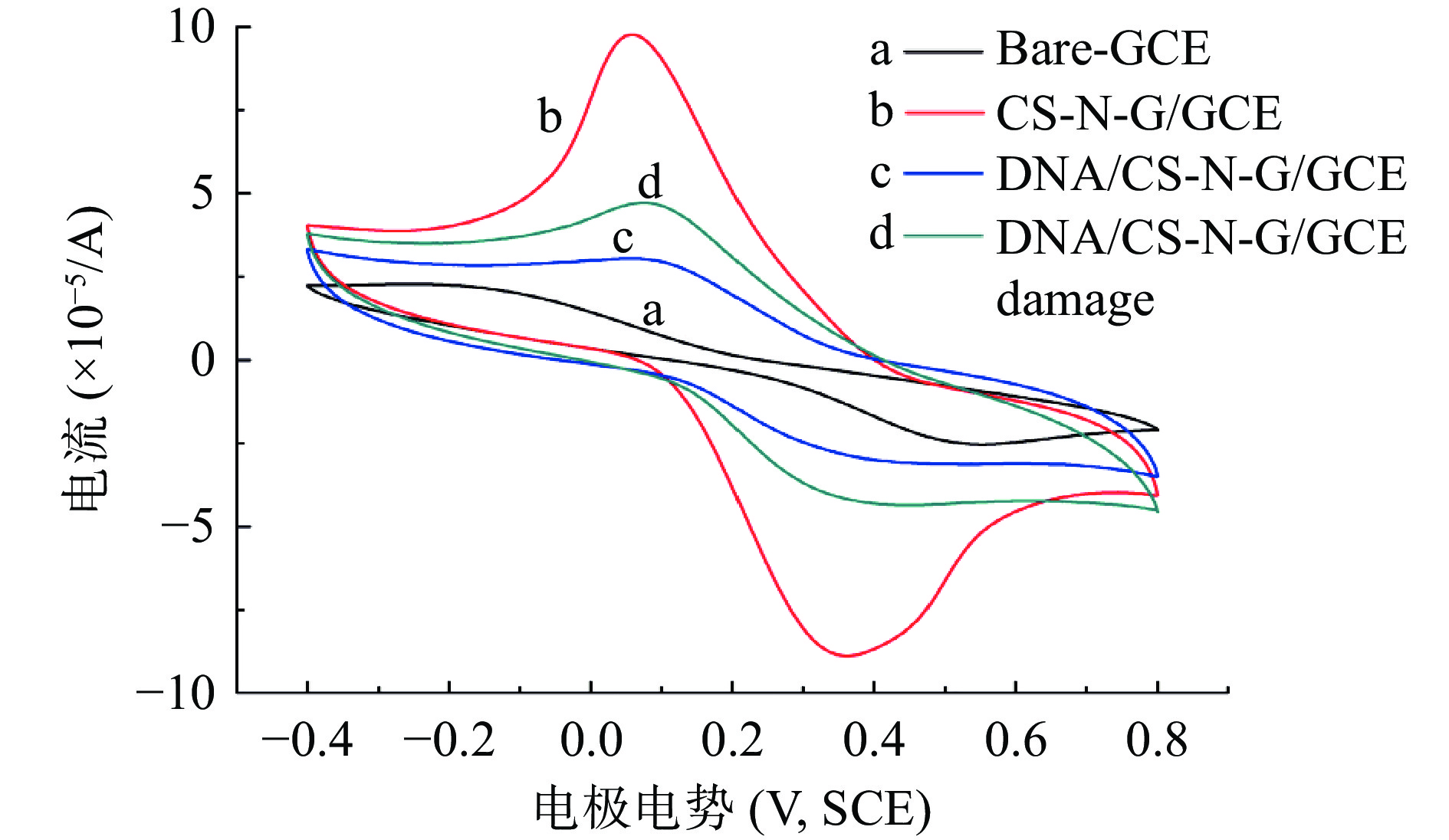Response Surface Optimization of the Preparation Process of Compound Yogurt with Cistanche deserticola and Jujube and Evaluation of the Antioxidant Activity of Compound Yogurt with Biosensors
-
摘要: 以肉苁蓉、红枣及酸奶为原料,以口感、组织状态、气味及色泽为评价指标,借助单因素实验和响应面曲线分析法对肉苁蓉红枣复合酸奶的制备工艺进行了优化,并利用DPPH 自由基清除体系和电化学生物传感器对复合酸奶的抗氧化活性进行了快速评价。由单因素实验和响应面分析法的结果可知,当红枣汁、肉苁蓉汁和蜂蜜的添加量为18%、8%和5%时,复合酸奶的品质最优,这时感官评分为92.2分,与预测值92.5分接近一致。在同等优化条件下,DNA、壳聚糖、氮掺杂石墨烯层层修饰玻碳电极所制备的DNA/CS-N-G/GCE生物传感器用于抗氧化活性评价时,L-抗坏血酸、复合酸奶和原味酸奶的电化学响应峰电流值依次为6.5×10−5、8.5×10−5、1.05×10−4 A,其活性大小依次为L-抗坏血酸>复合酸奶>原味酸奶。DPPH 自由基清除实验进一步验证显示,L-抗坏血酸、复合酸奶和原味酸奶的IC50 值依次为4.54、15.65和22.94 mg/mL,该结果与生物传感器的评价结果一致,且两种方法无显著性差异。上述结果表明原味酸奶中添加肉苁蓉、红枣提取物后显著增强了抑制自由基损伤DNA的作用,增加了复合酸奶的抗氧化性,构建的传感器可用于复合酸奶抗氧化活性的快速评价。Abstract: The preparation process of compound yogurt with added cistanche and jujube was optimized using single-factor experiments and response surface curve analysis by applying evaluation indicators including taste, texture, odor, and color. Besides, a rapid evaluation of the antioxidant activity of the compound yogurt was performed by employing the DPPH free radical scavenging system and electrochemical biosensors. Results of the single-factor experiments and response surface analysis indicated that the quality of the compound yogurt was optimal when the percentages of jujube juice, cistanche juice, and honey were 18%, 8%, and 5%, respectively. This composition achieved a sensory score of 92.2, which was close to the predicted score of 92.5. Under the same optimized conditions, the evaluation of the antioxidant activity with the preparation of DNA/CS-N-G/GCE biosensor obtained through the layer-by-layer modified glassy carbon electrode assembly of DNA, chitosan, and nitrogen-doped graphene indicated that L-ascorbic acid, compound yogurt, and plain yogurt present peak current values of 6.5×10−5、8.5×10−5 and 1.05×10−4 A, respectively. This represented a decreasing trend in antioxidant activity. Further validation of DPPH free radical scavenging experiments showed that the IC50 value of L-ascorbic acid, compound yogurt and plain yogurt were 4.54, 15.65 and 22.94 mg/mL, respectively. This was consistent with the results of the evaluation of the compound yogurt using the biosensor, and there was no significant difference between the two methods. Therefore, the addition of cistanche and jujube extracts into plain yogurt significantly enhanced the inhibition of damage to DNA by free radicals, thus improving the antioxidant activity in the compound yogurt. The constructed sensor could be used for the rapid evaluation of antioxidant activity of compound yogurt.
-
Keywords:
- cistanche /
- jujube /
- yogurt /
- process optimization /
- antioxidant activity /
- electrochemical biosensor /
- DNA
-
酸奶作为牛奶经乳酸菌发酵而成的产物,它具有口感细滑、营养丰富等特点,深受人们的喜爱[1]。随着人们收入的不断增加,消费者对酸奶市场的要求也不断提高。然而,当前酸奶市场品种单一,具有特色口味和功能的产品较少。因此,功能型的酸奶[2]出现在了大众的视野当中,与普通的酸奶相比, 功能型酸奶口味多样、营养丰富, 适合更广泛的消费群体, 所以功能型酸奶具有极高的研究价值。同时肉苁蓉作为分布于我国西北干旱地区的列当科肉苁蓉属植物的根茎[3],它具有补肾、改善便秘[4]和抗氧化[5]等功效。因此,近年来跟肉苁蓉相关的药食产品的开发深受研究者的广泛关注。红枣作为一种药食两用的鼠李科枣属植物,它含有丰富的营养物质,如氨基酸、多糖、维生素、核苷酸、黄酮类、有机酸和生物碱等,具有养血安神[6]、保护肠道[7]和清除自由基等[8]功效,其丰富的营养成分能同时满足消费者的需求,基于其所开发的各种食品、保健品等深受广大消费者的喜爱。可否将肉苁蓉、红枣以及酸奶三者有机的结合在一起,开发一款营养和口味俱佳,贴近消费者群体,满足消费者需求的功能型复合酸奶。
近年来,随着科技水平的不断提高,人们对食品中各种功能的研究[9]也逐步加深,如抗癌、抗氧化、抗疲劳、抗衰老等。因此,在众多功能型食品研制的过程中,抗氧化功能是人们研究的热门内容之一。研究抗氧化的方法[10]主要有活性氧自由基清除能力、基于氢原子转移、基于电子转移(SET)等方法,这些方法操作简单、成本较低,但是它的准确度较差、效率不高。因此亟待便捷、准确、高效和低成本的技术,电化学生物传感技术因其操作简便、快速,分析成本低等特点[11],已有将其用于中药提取物抗氧化活性评价的研究[12]。然而鲜有将其用于食品功能性如抗氧化活性等的评价研究。
本文以肉苁蓉、红枣、酸奶为原料,通过单因素实验和响应面曲线分析优化了复合酸奶的制备工艺。并利用构建的DNA 电化学生物传感器[13],以电极表面DNA在含有VC、肉苁蓉红枣复合酸奶或原味酸奶的Fenton 体系中的损伤程度为评价指标,对复合酸奶功能之一的抗氧化活性进行了评价[14]。该研究为该类产品的研发及地方特产的高值化开发利用,以及对同类产品的抗氧化性检测,开拓了思路,提供了参考。
1. 材料与方法
1.1 材料与仪器
红枣、蜂蜜、白砂糖、明胶、柠檬酸等 均为食品级,市售;新鲜肉苁蓉 阿拉善盟蓉天下生物科技有限公司;纯牛奶 君乐宝,市售;酸奶发酵剂,保加利亚乳酸杆菌(Lactobacillus bulgaricus):嗜热链球菌(Streptococcus thermophilus)1:1 北京川秀科技有限公司;鲱精DNA 美国Sigma-Aldrich公司;六铵合钌Ru(NH3)6Cl3 北京百灵威科技有限公司;氮参杂石墨烯,N-G 南京先丰纳米材料科技有限公司;L-抗坏血酸 上海中秦化学试剂有限公司;壳聚糖,CS 中国国药有限公司。
Brookfield CT质构仪 保圣实业发展有限公司;JYZ-E91型号榨汁机 山东九阳小家有限公司;FA1004精密电子天平 瑞普仪器仪表有限公司;MB-530酶标仪 上海聚慕医疗器械有限公司;ERS2000-4均质机 浙江恒岳仪器有限公司;HCSM-D灭菌机 昊利新科技发展有限公司;CHI 6041E型电化学工作站 上海辰华仪器有限公司,采用三电极体系,裸玻碳电极(GCE)或修饰电极为工作电极,铂丝(Pt)电极为辅助电极,饱和甘汞电极(SCE)为参比电极。
1.2 实验方法
1.2.1 酸奶制备的工艺
原料制备→调配→均质、杀菌→冷却→接种→发酵→冷藏后熟→加红枣汁→加肉苁蓉汁→加蜂蜜→加白砂糖→灌装→冷藏→成品
原料制备:分别挑选外形完整、新鲜、无腐烂的红枣以及新鲜、无损坏的肉苁蓉;将红枣预煮10 min使其软化后去核,将新鲜的肉苁蓉洗净、杀菌、切丁;分别将红枣和肉苁蓉按照与水料液比1:5和1:4 g/mL打浆,过150目筛,取上清液,冷藏备用。同时对纯牛奶进行净乳,将其冷却至10 ℃以下保存。
调配:将稳定剂以及辅料加入到牛奶中混合,加热至60~70 ℃,并循环搅拌20 min。
均质、杀菌:将混合好的料液进行均质,均质机压力25 MPa,杀菌温度为85 ℃,保持20 min。
冷却、接种及发酵[15]:将杀菌后的料液冷却至42 ℃,向冷却好的料液中加入4%的发酵剂在45 ℃的条件下恒温培养4 h,培养后送入2~6 ℃的冷藏设施内后熟24 h。
加入原料:将适当比例的红枣汁、肉苁蓉汁与发酵乳混合并搅拌,混匀后继续加入适当比例的蜂蜜和白砂糖继续搅拌混匀。
灌装、冷藏:将制备好的酸奶灌装入杯,严格检查品质及封合情况,立即送入4 ℃的冷藏设施内进行冷藏。
1.2.2 单因素实验
通过参考盛洁[16]、王玉茜[17]等酸奶单因素实验的方法,以感官评分为指标,确定各因素的适宜水平范围。研究酸奶发酵剂添加量(2%、3%、4%、5%、6%、7%)、红枣汁添加量(10%、12%、14%、16%、18%、20%)、肉苁蓉汁添加量(5%、6%、7%、8%、9%、10%)、白砂糖的添加量(4%、5%、6%、7%、8%、9%)、蜂蜜的添加量(1%、2%、3%、4%、5%、6%)对肉苁蓉红枣复合酸奶品质的影响。采用控制变量法,考察某一因素时,其他条件固定为酸奶发酵剂的添加量为4%,红枣汁的添加量为18%,肉苁蓉汁的添加量为8%,蜂蜜的添加量为5%,白砂糖的添加量为7%。
1.2.3 响应面设计试验
在单因素实验的基础上,参考成堃[18]、李翔[19]等响应面试验方法。选取对复合酸奶品质影响较大的3个因素(红枣汁添加量、肉苁蓉汁添加量、蜂蜜添加量)作为考察对象,以复合酸奶的感官评价为响应值,使用Design Expert 8.0.5软件进行三因素三水平的响应面分析,构建模型,进行拟合分析,从而获得复合酸奶的最佳工艺条件,响应面实验因素与水平如表1 所示。
表 1 响应面设计因素及水平Table 1. Response surface design factors and levels水平 因素 A红枣汁的添加量
(%)B肉苁蓉汁的添加量
(%)C蜂蜜的添加量
(%)−1 16 7 4 0 18 8 5 1 20 9 6 1.2.4 产品的感官评价
选10 名专业的感官评价人员组成评定小组,进行感官评价。根据酸奶的评价指标(口感、组织状态、气味、色泽)对产品进行评分。收集组内成员的评定结果,取3次平均值作为感官评价的结果,感官评价标准如表2所示。
表 2 酸奶感官评定表Table 2. Sensory evaluation of yogurt评分项目 评分标准 分值 口感
(30分)较甜、较苦或较酸 0~9 基本适口或较黏腻 10~19 口感细腻、爽口 20~30 组织状态
(30分)不均匀、有乳清大量或出现分层现象 0~9 均匀一致,有乳清少量析出或没有分层现象 10~19 均匀一致,或无乳清析出 20~30 气味
(20分)无奶香或无肉苁蓉红枣香味 0~8 肉苁蓉红枣香味不协调、奶香清淡或香味过浓 9~14 有肉苁蓉红枣的香味、香味适宜或奶香浓郁 15~20 色泽
(20分)酸奶颜色不鲜亮 0~8 酸奶色泽较为鲜亮 9~14 酸奶颜色鲜亮 15~20 1.2.5 抗氧化活性测定
1.2.5.1 DNA/CS-N-G/GCE修饰电极的制备
参考孙伯禄等[20]的方法,首先将GCE分别在含有0.3和0.05 μm的抛光粉(Al2O3)的麂皮上反复打磨至光滑,然后将其分别放入甲醇和蒸馏水中各超声10 min,将其拿出用蒸馏水冲洗表面,放到自然处晾干。在处理好的GCE 表面滴涂10 μL 1.0 mg/mL的CS-N-G(0.2% CS:称取壳聚糖0.2 g,用2%的醋酸定容至100 mL;将1 mg N-G与1 mL的0.2% CS,超声2 h),在30 ℃红外灯下进行烤干,在表面形成一层薄膜。然后滴涂5 μL 1.5 mg/mL鲱精DNA溶液(取15 mg DNA,用二次蒸馏水定容至10 mL),4 ℃自然晾干。用pH7.0的PBS溶液洗去电极表面吸附不牢的DNA,得到DNA/CS-N-G/GCE。每修饰一层,采用循环伏安法[21](CV),对修饰好的电极进行测量,循环伏安法条件为:电压范围为−0.4~0.8 V;扫速100 mV/s。电解质溶液为5 mmol/L [Fe(CN)6]3−/4−,0.1mol/L KCL溶液。
1.2.5.2 DNA氧化损伤的过程检测
以Ru(NH3)63+为探针溶液(1.0 mmol/L 含50 mmol/L KCl)采用SWV(方波伏安法)对修饰好的DNA/CS-N-G/GCE电极进行扫描(振幅为25 mV,扫描电压范围为−0.4~0.8 V)得到损伤前的电化学响应[22]。将相同的电极打磨修饰,完成后放入含有抗氧化剂的Fenton试剂(pH7.0的PBS溶液,含1 mmol/L FeSO4和5 mmol/L H2O2)中室温温育30 min(抗氧化剂:L-抗坏血酸被Fenton溶液稀释为1 mmol/L),拿出后用pH7.0的PBS溶液冲洗电极,再将其置入Ru(NH3)63+溶液中进行SWV扫描,检测对DNA损伤的抑制作用。同理,将再次修饰好的电极,放入Fenton试剂中室温温育30 min,将其取出后用pH7.0的PBS溶液冲洗电极,冲洗完后进行扫描,得到损伤后的电化学响应。
1.2.5.3 复合酸奶抗氧化性的检测
重复1.2.5.2 中对DNA损伤过程的检测,在此基础上将修饰好的电极再放入分别含有L-抗坏血酸(VC)、复合酸奶、和原味酸奶的Fenton试剂中室温温育30 min,用pH7.0的PBS溶液冲洗电极,电极置入Ru(NH3)63+溶液中进行方波伏安扫描(每检测一次,电极重新进行打磨修饰),根据峰电流比值来衡量抗氧化剂的抗氧化性能。复合酸奶及原味酸奶用Fenton溶液稀释成抗氧化剂溶液,浓度为17.6 mg/mL。
1.2.5.4 DPPH自由基清除能力的检测
通过对L-抗坏血酸(VC)、复合酸奶和原味酸奶对DPPH 自由基清除能力的检测,验证电化学生物传感器评价肉苁蓉红枣复合酸奶抗氧化能力的可靠性,通过参考徐艳等[23]方法对复合酸奶DPPH自由基清除抗氧化活性进行了评价,并以原味酸奶和VC为对照。首先复合酸奶、原味酸奶和VC分别用蒸馏水进行萃取,配制成5、10、15、20、25 mg/mL的溶液。接着取1 mL 的样品溶液,加入1 mL的0.2 mmol/L的DPPH溶液(称取0.0079 g DPPH粉末,用无水乙醇溶解定容至100 mL棕色容量瓶),在27 ℃条件下加热15 min,然后在波长517 nm处测定吸光度值(Ai);取1 mL的样品溶液,加入1 mL的0.2 mmol/L的DPPH溶液,在517 nm处测定样品本底吸光值(Aj);以蒸馏水代替样品作为空白对照测定空白吸光度值(A0);所有样品重复3次。分别计算复合酸奶、原味酸奶和VC对DPPH自由基的清除率(R),计算公式如下:
R(%)=[1−(Ai−Aj)/A0]×100 1.3 数据处理
采用Design Expert 8.0.5 软件对数据处理,进行响应面分析;用IBM SPSS Statistics 26.0软件进行相对标准偏差和T检验分析;抗氧化性能数据分析采用Excel 2016版本,使用Origin Pro 2020 软件进行绘图。所有实验均平行测定3次。
2. 结果与分析
2.1 单因素实验
2.1.1 酸奶发酵剂添加量对酸奶感官评分的影响
酸奶发酵剂的添加量对复合酸奶感官评分的影响由图1可知,随着酸奶发酵剂添加量的增加,复合酸奶的感官评分呈现出先上升后下降的趋势。当酸奶发酵剂添加量为2%时,不足以产生足够多的乳酸,导致发酵不完全,组织性较差,感官评分最低。随着添加量的增加,感官评分逐渐上升,当酸奶发酵剂的添加量为4%时,感官评分最高,分值平均值为87分,这时组织状态均匀、酸度适中。当酸奶发酵剂添加量大于4%时,随着添加量的不断增大,酸奶的味道发生变化,感官评分开始下降,这有可能是因为乳酸含量增加,有乳清析出,影响了感官评分。因此,酸奶发酵剂最佳添加量为4%。
2.1.2 红枣汁添加量对酸奶感官评分的影响
红枣汁的添加量对复合酸奶感官评分的影响由图2可知,随着红枣汁添加量的增大,复合酸奶的感官评分呈先增大后减小的趋势,红枣汁添加量为10%时,复合酸奶中枣味不明显,味道偏淡,影响了复合酸奶的感官评分,随着红枣汁量的增加,感官评分逐渐上升,当红枣汁添加量为18%时,复合酸奶口感细腻、颜色鲜亮,感官评分最高,分值平均值为92分,红枣汁添加量高于18%时,感官评分降低,产品枣味过浓,掩盖了酸奶的香气,组织状态差,有乳清析出。因此,红枣汁最佳添加量为18%。
2.1.3 肉苁蓉汁添加量对酸奶感官评分的影响
肉苁蓉汁的添加量对复合酸奶感官评分的影响由图3可知,随着肉苁蓉汁添加量的增加,复合酸奶的感官评分呈现出先上升后下降的趋势,当添加量为5%时,肉苁蓉的香气被红枣和酸奶的风味掩盖,风味较差,因此评分较低。随着肉苁蓉汁的不断添加,感官评分逐渐上升,当肉苁蓉汁的添加量为8%时,复合酸奶的感官评分最高,分值平均值为90分,这时复合酸奶的红枣香气、肉苁蓉特征香气与奶香相互谐调、口感爽滑细腻。当肉苁蓉汁添加量高于8%时,感官评分迅速下降,此时复合酸奶肉苁蓉涩味较重,影响食欲。因此,肉苁蓉汁最佳添加量为8%。
2.1.4 蜂蜜添加量对酸奶感官评分的影响
蜂蜜的添加量对复合酸奶感官评分的影响由图4 可知,随着蜂蜜添加量的增加,复合酸奶的感官评分呈现出先上升后下降的趋势,蜂蜜的添加量为1%时,复合酸奶的口感不够爽滑、状态稀薄、风味不易被接受,因此复合酸奶的感官评分最低。随着蜂蜜添加量的不断增加,复合酸奶的感官评分也不断增加,当蜂蜜的添加量为5%时,复合酸奶的风味较好、酸甜适宜、粘稠度高,在此条件下复合酸奶的感官评分最高,分值平均值为89分。当添加量超过5%时,酸奶过甜、风味变差、凝固状态变差,酸奶表面出现颗粒物质。因此,蜂蜜最佳添加量为5%。
2.1.5 白砂糖添加量对酸奶感官评分的影响
白砂糖的添加量对复合酸奶感官评分的影响由图5可知,随着白砂糖添加量的增加,复合酸奶的感官评分呈现出先上升后下降的趋势。白砂糖添加量为4%时感官评分最低,这主要是因为复合酸奶甜度不够、口感发酸、香气不良。随着白砂糖添加量不断增加,感官评分逐渐上升,当白砂糖添加量为7%时,感官评分最高,分值平均值为87分,这时复合酸奶其香味协调,甜度适中。白砂糖会影响酸奶的质地和甜度,当白砂糖添加量超过7%时,会导致酸奶甜度过高,影响酸度,且酸奶凝乳不均匀。因此,白砂糖最佳添加量为7%。
2.2 响应面试验优化结果
2.2.1 响应面试验设计及结果
以肉苁蓉红枣复合酸奶的感官评分为响应值(Y),选取红枣汁的添加量(A)、肉苁蓉汁的添加量(B)、蜂蜜的添加量(C)为主要因素的自变量进行响应面试验设计[24],进一步优化肉苁蓉红枣复合酸奶的工艺,随机进行试验,试验方案与结果见表3。
表 3 响应面试验方案与结果Table 3. Experimental design and results of response surface methodology实验号 A B C 感官评分(分) 1 1 0 1 89 2 0 0 0 92 3 1 −1 0 88 4 −1 −1 0 80 5 0 1 −1 70 6 1 1 0 78 7 1 0 −1 84 8 0 0 0 93 9 0 1 1 83 10 −1 0 −1 74 11 0 0 0 91 12 0 −1 1 85 13 −1 0 1 86 14 0 0 0 94 15 0 −1 −1 82 16 0 0 0 93 17 −1 1 0 73 2.2.2 响应面回归模型的方差分析
采用Design Expert 8.0.5软件对表3 进行回归拟合与方差分析[25]得回归方程:
Y=92.60+3.25A−3.87B+4.13C−0.75AB−1.75AC+2.50BC−4.80A2−8.05B2−4.55C2
回归方程方差分析见表4。由表4 可知,模型的P值<0.0001为极显著,失拟项P值>0.05为不显著,证明结果与实际符合。一次项A、B、C和交互项AC、BC及二次项A2、B2、C2对结果影响极显著(P<0.0001),其他项对结果影响不显著(P>0.05)。决定系数R2=0.9835,校正决定系数RAdj2=0.9685说明此模型与数据拟合度很高,试验误差小,预测结果较好。根据F值的大小,得出肉苁蓉红枣复合酸奶感官评分受各因素的影响次序为:C(蜂蜜的添加量)>B(肉苁蓉汁的添加量)>A(红枣汁的添加量)。
表 4 回归方程方差分析Table 4. Variance analysis of regression equation方差来源 平方和 自由度 均方 F值 P值 显著性 模型 885.67 9 98.41 106.80 <0.0001 ** A 84.50 1 84.50 91.71 <0.0001 ** B 120.12 1 120.12 130.67 <0.0001 ** C 136.13 1 136.13 147.73 <0.0001 ** AB 2.25 1 2.25 2.44 0.1269 不显著 AC 12.25 1 12.25 13.29 0.0049 ** BC 25.00 1 25.00 27.13 0.0007 ** A2 97.01 1 97.01 105.28 <0.0001 ** B2 272.85 1 272.85 292.12 <0.0001 ** C2 87.17 1 87.17 84.60 <0.0001 ** 残差 6.45 7 0.9214 失拟项 1.25 3 0.4617 0.3205 0.8115 不显著 净误差 5.20 4 1.30 总和 892.12 16 决定系数R2 0.9835 校正决定系数RAdj2 0.9685 注:P<0.01指极显著,用“**”表示;P>0.05为不显著;表7~表8同。 2.2.3 产品的感官评分的响应面图分析
通过对回归方程的分析[26],得到以感官评分为响应值的红枣汁、肉苁蓉汁和蜂蜜添加量这3个因素交互作用的响应面图和等高线图,结果见图6~图8。
由图6a可知,肉苁蓉红枣复合酸奶的感官评分随着红枣汁和肉苁蓉汁的添加,呈现先上升后下降的趋势,但总体起伏较为平缓,变化值不是很明显。从图6b可知,红枣汁和肉苁蓉汁添加量之间交互作用的等高线趋近于圆形,表明两者之间的交互作用对感官评分影响不显著。
由图7a可知,当蜂蜜添加量一定时,感官评分随着红枣汁添加量的增加呈现先上升后下降的趋势,总体起伏较为平缓。当红枣汁添加量一定时,感官评分随着蜂蜜添加量的增加呈现先缓慢增加后快速减少的趋势,总体起伏较大,所以蜂蜜添加量对感官评分具有较大的影响。从图7b可知,蜂蜜和红枣汁添加量交互作用等高线趋近于椭圆形,表明二者之间的交互作用对感官评分影响极显著。
由图8a可知,当肉苁蓉汁添加量一定时,感官评分随着蜂蜜添加量的增加呈现先增加后减少的趋势,从总体上看变化值并不明显,但蜂蜜添加量感官评价的分值始终高于肉苁蓉汁添加量感官评价的分值。当蜂蜜添加量一定时,感官评分随着肉苁蓉汁添加量的增加呈现先缓慢增加后快速减少的趋势,总体起伏较大,所以肉苁蓉汁添加量对感官评分也具有较大的影响。从图8b可知,肉苁蓉汁和蜂蜜添加量交互作用的等高线趋近于椭圆形,表明二者之间的交互作用对感官评分影响极显著。
2.2.4 复合酸奶工艺参数的确定
利用Design Expert 8.0.5软件对所得回归方程进行分析求解,确定复合酸奶制备工艺的最佳参数。当红枣汁、肉苁蓉汁和蜂蜜的添加量分别为18%、8%、5%时,复合酸奶的品质最优,感官评分为92.2分,与预测值92.5分极为接近。说明真实值与该模型预测值二者拟合良好,对复合酸奶进行配方优化具有可操作性[27]。
2.3 复合酸奶的抗氧化活性评价
2.3.1 修饰电极的电化学表征
由图9 可知,曲线a为[Fe(CN)6]3−/4−在裸GCE电极上的氧化还原峰,在裸电极表面修饰CS-N-G后,氧化还原峰值增大(曲线b),这主要是CS和N-G促进了电子转移,使电极具有良好的导电性[28],在修饰DNA/CS-N-G/GCE后,[Fe(CN)6]3−/4−上的氧化还原峰基本消失(曲线c),当DNA/CS-N-G/GCE在Fenton试剂中损伤一段时间后,[Fe(CN)6]3−/4−的氧化还原峰有所上升(曲线d),这表明当DNA负载到电极上时形成的膜阻碍了[Fe(CN)6]3−/4−电极上的电化学响应[29],当ds-DNA形成的膜被破坏后,[Fe(CN)6]3−/4−的氧化还原峰有所上升,但峰值较低。
2.3.2 DNA损伤以及复合酸奶抗氧化性的电化学检测
由图10A可知DNA/CS-N-G/GCE 在Fenton试剂中损伤30 min后所检测到的氧化还原峰最高(曲线c),损伤前所检测到的氧化还原峰最低(曲线a),这主要是由于ds-DNA在电极表面形成了一层薄膜,从而阻碍了电极上的电化学响应峰电流下降。将修饰好的电极放入Fenton试剂中进行温育,在反应的过程中生成了·OH攻击膜内的ds-DNA,对DNA 造成了损伤,进而氧化还原峰上升[30]。当在Fenton试剂中加入VC形成抗氧化剂时,其氧化还原峰(曲线b)有所下降,说明抗坏血酸作为抗氧化剂对Fenton反应引起的DNA损伤具有良好的保护作用。在图10B中,修饰好的电极以Ru(NH3)63+为探针,检测到损伤前(曲线a)的氧化还原峰最低,当在Fenton溶液中加入L-抗坏血酸(VC曲线b)、复合酸奶(曲线c)、原味酸奶(曲线d)形成抗氧化剂时,其所检测到的氧化还原峰与损伤后(曲线e)检测到最高的氧化还原峰相比有所下降,这主要是VC、复合酸奶以及原味酸奶作为抗氧化剂,能够有效的清除一些自由基,对DNA损伤具有一定的保护作用,而VC作为强抗氧化剂其清除自由基的能力高于复合酸奶和原味酸奶,而复合酸奶中添加了肉苁蓉和红枣,肉苁蓉中的苯乙醇苷以及红枣中的多酚类物质具有良好的抗氧化作用。因此,由DNA生物传感器评价抗氧化活性结果可知,其抗氧化能力为L-抗坏血酸(VC)>复合酸奶>原味酸奶。
![]() 图 10 电极的DNA损伤检测和复合酸奶抗氧化性的电化学检测的方波伏安图注:图10A为电极在1.0 mmol/L(含50 mmol/L KCl)Ru(NH3)63+溶液中的DNA损伤检测图,在图中a为电极被DNA修饰后损伤前的曲线;b为在含有抗氧剂中的Fenton试剂中损伤30 min后的曲线;c为在Fenton试剂中损伤30 min后的曲线;图10B为电极在含有不同抗氧化剂的Fenton溶液损伤30 min抗氧化性检测的方波伏安图,其中a为电极被DNA修饰后损伤前的曲线;b为在含有抗氧剂VC中的Fenton试剂中损伤30 min后的曲线;c为含有抗氧剂复合酸奶为在Fenton试剂中损伤30 min后的曲线;d为含有抗氧剂原味酸奶为在Fenton试剂中损伤30 min 后的曲线;e为在Fenton试剂中损伤30 min后的曲线。Figure 10. DNA damage detection of electrodes and the electrochemical test chart of the antioxidant activity of compound yogurt by square wave voltammetry
图 10 电极的DNA损伤检测和复合酸奶抗氧化性的电化学检测的方波伏安图注:图10A为电极在1.0 mmol/L(含50 mmol/L KCl)Ru(NH3)63+溶液中的DNA损伤检测图,在图中a为电极被DNA修饰后损伤前的曲线;b为在含有抗氧剂中的Fenton试剂中损伤30 min后的曲线;c为在Fenton试剂中损伤30 min后的曲线;图10B为电极在含有不同抗氧化剂的Fenton溶液损伤30 min抗氧化性检测的方波伏安图,其中a为电极被DNA修饰后损伤前的曲线;b为在含有抗氧剂VC中的Fenton试剂中损伤30 min后的曲线;c为含有抗氧剂复合酸奶为在Fenton试剂中损伤30 min后的曲线;d为含有抗氧剂原味酸奶为在Fenton试剂中损伤30 min 后的曲线;e为在Fenton试剂中损伤30 min后的曲线。Figure 10. DNA damage detection of electrodes and the electrochemical test chart of the antioxidant activity of compound yogurt by square wave voltammetry2.3.3 DPPH自由基清除能力的测定
由图11可知,DPPH 自由基清除率随着样品浓度的增加而增加,通过拟合方程计算得L-抗坏血酸、复合酸奶和原味酸奶的DPPH 由基的IC50值分别为4.54、15.65、22.94 mg/mL,其抗氧化活性大小依次为L-抗坏血酸、复合酸奶、原味酸奶,这主要是肉苁蓉中的苯乙醇苷以及红枣中的多酚类物质增强了复合酸奶的抗氧化性。
2.3.4 电化学生物传感器稳定性和准确性的研究
重复1.2.5抗氧化活性测定的步骤,相同的实验条件下(各抗氧化剂的浓度为1 mmol/L),通过电化学生物传感器评价和DPPH自由基清除法对L-抗坏血酸、复合酸奶和原味酸奶的抗氧化活性分别进行评价,每个方法进行3次平行实验,记录检测值,对测得的每一种抗氧化剂的峰电流值以及自由基清除率结果进行相对标准差的计算和T检验分析,结果见表5~表8。
表 5 三种抗氧化剂峰电流值的相对标准偏差Table 5. Relative standard deviation of peak current value for three antioxidants抗氧化剂 峰电流值(×10−5/A) 标准偏差S RSD(%) 1 2 3 L-坏血酸 6.5 6.7 6.4 0.1528 2.3 复合酸奶 8.9 8.4 8.3 0.3215 3.8 原味酸奶 10.5 10.7 9.8 0.4726 4.6 表 6 三种抗氧化剂DPPH自由基清除率的相对标准偏差Table 6. Three antioxidants DPPH radical scavenging rate relative standard deviation抗氧化剂 自由基清除率(%) 标准偏差S RSD(%) 1 2 3 L-抗坏血酸 86.02 80.11 84.09 83.333 3.7 复合酸奶 61.04 58.20 63.13 60.667 4.1 原味酸奶 42.14 41.10 45.07 42.667 4.9 表 7 三种抗氧化剂峰电流值的样本T检验分析结果Table 7. Sample T-test analysis results of peak current value for three antioxidants名词 样本量 最小值 最大值 平均值 标准差 T值 P值 L-抗坏血酸 3 6.4 6.7 6.533 0.153 74.081 0.000** 复合酸奶 3 8.3 8.9 9.6 0.3 49.652 0.000** 原味酸奶 3 9.8 10.7 10.333 0.473 37.873 0.001** 表 8 三种抗氧化剂DPPH 自由基清除率样本T检验分析结果Table 8. Three antioxidant DPPH free radical scavenging rate sample T-test analysis results名词 样本量 最小值 最大值 平均值 标准差 T值 P值 L-抗坏血酸 3 80 86 83.333 3.055 47.246 0.000** 复合酸奶 3 58 63 60.667 2.517 41.754 0.001** 原味酸奶 3 41 45 42.667 2.082 35.501 0.001** 由表5可知,三种抗氧化剂由方波伏安法检测的峰电流值相对标准偏差分别为2.3%、3.8%、4.6%。
由表6 结果,DPPH自由基的清除率由大到小依次为L-抗坏血酸(VC)、复合酸奶、原味酸奶,且RSD值分别为3.7%、4.1%、4.9%。
根据电化学生物感器评价和DPPH自由基清除法对三种抗氧化剂进行测定的相对标准偏差结果可知,在相同条件下,电化学生物传感器评价的结果优于DPPH自由基清除法的评价结果,表明用来检测复合酸奶抗氧化性的电化学生物传感器具有良好的稳定性。
由表7、表8可知,L-抗坏血酸、复合酸奶和原味酸奶的电化学生物传感器测定的峰电流值以及自由基清除率的P值均小于0.01为极其显著,说明用电化学生物传感器和DPPH自由基的清除体系对L-抗坏血酸、复合酸奶、原味酸奶进行抗氧化活性评价具有可行性,实验结果较为可靠,且电化学生物传感器评价与DPPH自由基清除结果一致,三种抗氧化剂的抗氧化活性为L-抗坏血酸>复合酸奶>原味酸奶。由此证明构建的电化学生物传感器用于复合酸奶抗氧化性评价时具有较佳的稳定性和准确性,且方法相对便捷高效。
3. 结论
以感官评分为指标,采用单因素和响应面试验对影响肉苁蓉红枣复合酸奶感官评分的红枣汁、肉苁蓉汁和蜂蜜的添加量3个因素进行工艺优化,同时利用DNA电化学生物传感器和DPPH自由基清除体系对复合酸奶的抗氧化活性进行评价。由单因素和响应面试验的结果可得复合酸奶的最佳工艺为:红枣汁添加量为18%、肉苁蓉汁的添加量为8%、蜂蜜的添加量为5%,由此工艺所得酸奶质地均匀、组织细腻、口感更佳,感官评分最高。在同等优化条件下,当DNA/CS-N-G/GCE 生物传感器用于抗氧化活性评价时L-抗坏血酸、复合酸奶和原味酸奶的峰电流值分别为6.5×10−5、8.5×10−5、1.05×10−4 A,其抗氧化活性大小分别为L-抗坏血酸、复合酸奶、原味酸奶。DPPH 自由基清除实验进一步验证显示,L-抗坏血酸、复合酸奶和原味酸奶的IC50 值依次为4.54、15.65、22.94 mg/mL,该结果与生物传感器的评价结果一致。这表明本工艺所制备的肉苁蓉红枣复合酸奶具有一定的抗氧化作用,不仅为肉苁蓉红枣复合酸奶工艺的优化提供了参考,而且还为生物传感技术介入食品功能性评价拓展了思路。
-
图 10 电极的DNA损伤检测和复合酸奶抗氧化性的电化学检测的方波伏安图
注:图10A为电极在1.0 mmol/L(含50 mmol/L KCl)Ru(NH3)63+溶液中的DNA损伤检测图,在图中a为电极被DNA修饰后损伤前的曲线;b为在含有抗氧剂中的Fenton试剂中损伤30 min后的曲线;c为在Fenton试剂中损伤30 min后的曲线;图10B为电极在含有不同抗氧化剂的Fenton溶液损伤30 min抗氧化性检测的方波伏安图,其中a为电极被DNA修饰后损伤前的曲线;b为在含有抗氧剂VC中的Fenton试剂中损伤30 min后的曲线;c为含有抗氧剂复合酸奶为在Fenton试剂中损伤30 min后的曲线;d为含有抗氧剂原味酸奶为在Fenton试剂中损伤30 min 后的曲线;e为在Fenton试剂中损伤30 min后的曲线。
Figure 10. DNA damage detection of electrodes and the electrochemical test chart of the antioxidant activity of compound yogurt by square wave voltammetry
表 1 响应面设计因素及水平
Table 1 Response surface design factors and levels
水平 因素 A红枣汁的添加量
(%)B肉苁蓉汁的添加量
(%)C蜂蜜的添加量
(%)−1 16 7 4 0 18 8 5 1 20 9 6 表 2 酸奶感官评定表
Table 2 Sensory evaluation of yogurt
评分项目 评分标准 分值 口感
(30分)较甜、较苦或较酸 0~9 基本适口或较黏腻 10~19 口感细腻、爽口 20~30 组织状态
(30分)不均匀、有乳清大量或出现分层现象 0~9 均匀一致,有乳清少量析出或没有分层现象 10~19 均匀一致,或无乳清析出 20~30 气味
(20分)无奶香或无肉苁蓉红枣香味 0~8 肉苁蓉红枣香味不协调、奶香清淡或香味过浓 9~14 有肉苁蓉红枣的香味、香味适宜或奶香浓郁 15~20 色泽
(20分)酸奶颜色不鲜亮 0~8 酸奶色泽较为鲜亮 9~14 酸奶颜色鲜亮 15~20 表 3 响应面试验方案与结果
Table 3 Experimental design and results of response surface methodology
实验号 A B C 感官评分(分) 1 1 0 1 89 2 0 0 0 92 3 1 −1 0 88 4 −1 −1 0 80 5 0 1 −1 70 6 1 1 0 78 7 1 0 −1 84 8 0 0 0 93 9 0 1 1 83 10 −1 0 −1 74 11 0 0 0 91 12 0 −1 1 85 13 −1 0 1 86 14 0 0 0 94 15 0 −1 −1 82 16 0 0 0 93 17 −1 1 0 73 表 4 回归方程方差分析
Table 4 Variance analysis of regression equation
方差来源 平方和 自由度 均方 F值 P值 显著性 模型 885.67 9 98.41 106.80 <0.0001 ** A 84.50 1 84.50 91.71 <0.0001 ** B 120.12 1 120.12 130.67 <0.0001 ** C 136.13 1 136.13 147.73 <0.0001 ** AB 2.25 1 2.25 2.44 0.1269 不显著 AC 12.25 1 12.25 13.29 0.0049 ** BC 25.00 1 25.00 27.13 0.0007 ** A2 97.01 1 97.01 105.28 <0.0001 ** B2 272.85 1 272.85 292.12 <0.0001 ** C2 87.17 1 87.17 84.60 <0.0001 ** 残差 6.45 7 0.9214 失拟项 1.25 3 0.4617 0.3205 0.8115 不显著 净误差 5.20 4 1.30 总和 892.12 16 决定系数R2 0.9835 校正决定系数RAdj2 0.9685 注:P<0.01指极显著,用“**”表示;P>0.05为不显著;表7~表8同。 表 5 三种抗氧化剂峰电流值的相对标准偏差
Table 5 Relative standard deviation of peak current value for three antioxidants
抗氧化剂 峰电流值(×10−5/A) 标准偏差S RSD(%) 1 2 3 L-坏血酸 6.5 6.7 6.4 0.1528 2.3 复合酸奶 8.9 8.4 8.3 0.3215 3.8 原味酸奶 10.5 10.7 9.8 0.4726 4.6 表 6 三种抗氧化剂DPPH自由基清除率的相对标准偏差
Table 6 Three antioxidants DPPH radical scavenging rate relative standard deviation
抗氧化剂 自由基清除率(%) 标准偏差S RSD(%) 1 2 3 L-抗坏血酸 86.02 80.11 84.09 83.333 3.7 复合酸奶 61.04 58.20 63.13 60.667 4.1 原味酸奶 42.14 41.10 45.07 42.667 4.9 表 7 三种抗氧化剂峰电流值的样本T检验分析结果
Table 7 Sample T-test analysis results of peak current value for three antioxidants
名词 样本量 最小值 最大值 平均值 标准差 T值 P值 L-抗坏血酸 3 6.4 6.7 6.533 0.153 74.081 0.000** 复合酸奶 3 8.3 8.9 9.6 0.3 49.652 0.000** 原味酸奶 3 9.8 10.7 10.333 0.473 37.873 0.001** 表 8 三种抗氧化剂DPPH 自由基清除率样本T检验分析结果
Table 8 Three antioxidant DPPH free radical scavenging rate sample T-test analysis results
名词 样本量 最小值 最大值 平均值 标准差 T值 P值 L-抗坏血酸 3 80 86 83.333 3.055 47.246 0.000** 复合酸奶 3 58 63 60.667 2.517 41.754 0.001** 原味酸奶 3 41 45 42.667 2.082 35.501 0.001** -
[1] 霍晓娜, 曹志强. 我国酸奶市场竞争格局与发展趋势[J]. 中国乳业,2018(3):8−10. [HUO X N, CAO Z Q. The competition pattern and development trend of yogurt market in China[J]. China Dairy,2018(3):8−10. [2] 陶春光. 功能性酸奶研发现状与菌株法律保护体系建立[J]. 食品研究与开发,2017,38(7):210−213. [TAO C G. Research and development present situation of functional yogurt and strain legal protection system[J]. Food Research and Development,2017,38(7):210−213. doi: 10.3969/j.issn.1005-6521.2017.07.047 [3] 赵阳武. 不同接种年限肉苁蓉指标成分和功效的研究[D]. 兰州: 甘肃农业大学, 2018. ZHAO Y W. The study of contents and efficiencies of different inoculation years Cistanches desertricola[D]. Lanzhou: Gansu Agricultural University, 2018.
[4] CAO L B, GONG X C, JIA J R, et al. Rapid c hemome profiling of Cistanche salsa using DI-MS/MS~(ALL)][J]. China Journal of Chinese Materia Medica,2021,46(16):4150−4156.
[5] GUO Y H, GAO L L, ZHAO Q S, et al. Preliminary characterizations, antioxidant and hepatoprotective activity of polysaccharide from Cistanche deserticola[J]. International Journal of Biological Macromolecules,2016,93:678−685. doi: 10.1016/j.ijbiomac.2016.09.039
[6] 朱星宇, 郭东起. 红枣关键功能成分及其生物活性的研究进展[J]. 食品研究与开发,2021,42(8):197−201. [ZHU X Y, GUO D Q. Research advancement on key functional components and biological activities of red jujubes[J]. Food Research and Development,2021,42(8):197−201. doi: 10.12161/j.issn.1005-6521.2021.08.032 [7] LI J C, HUANG G L. Extraction, purification, separation, structure, derivatization and activities of polysaccharide from Chinese date[J]. Process Biochemistry,2021,110:231−242. doi: 10.1016/j.procbio.2021.08.018
[8] LI J, ZAHO W T, PAN X, et al. Improvement of antioxidant properties of jujube puree by biotransformation of polyphenols via Streptococcus thermophilus fermentation[J]. Food Chemistry,2022:100214.
[9] 苑翼楠, 周威. “药食同源”类食品国内外研究现状及展望[J]. 现代食品,2021(14):118−121. [YUAN Y N, ZHOU W. Existing research and prospect of "Homology of Medicine and Food" in China and abroad[J]. Modern Food,2021(14):118−121. [10] NORA A. Evaluating the effects of different processing methods on the nutritional composition of shrimp and the antioxidant activity of shrimp powder [J]. Saudi Journal of Biological Sciences, 2022, 29 (1): 640-649.
[11] MAO X Y, ZHU L Q, LIU H C, et al. Cu/graphene composite coatings electrodeposited in a directly dispersed graphene solution after electrochemical exfoliation with enhanced oxidation resistance[J]. Journal of Alloys and Compounds,2021,882:160706. doi: 10.1016/j.jallcom.2021.160706
[12] JIANG P J, LE T S, ZHI Y C, et al. Evaluation of antioxidant-associated efficacy of flavonoid extracts from a traditional Chinese medicine Hua Ju Hong (peels of Citrus grandis (L.) Osbeck)[J]. Journal of Ethnopharmacology,2014,158:325−330. doi: 10.1016/j.jep.2014.10.039
[13] MACHINI W B S, BREET A M. In situ electrochemical investigation of the interaction between bacteria Xylella fastidiosa DNA and using DNA-electrochemical biosensors[J]. Electrochemistry Communications,2021,125:106975. doi: 10.1016/j.elecom.2021.106975
[14] 刘福鑫. 构建新型过氧亚硝基阴离子传感器及对抗氧化剂的研究[D]. 兰州: 西北师范大学, 2020. LIU F X. Construction of novel peroxynitrite anion sensor and research of antioxidants[D]. Lanzhou: Northwest Normal University, 2020.
[15] 贺莹. 响应面优化小米酸奶工艺优化[J]. 食品工业,2019,40(10):19−22. [HE Y. Research and development of response surface optimization of millet yoghurt[J]. The Food Industry,2019,40(10):19−22. [16] 盛洁, 田欢, 刘原野, 等. 响应面法优化红枣益生菌发酵饮料工艺[J]. 中国酿造,2021,40(2):203−209. [SHENG J, TIAN H, LIU Y Y, et al. Optimization of fermentation process of probiotics jujube beverage by response surface methodology[J]. China Brewing,2021,40(2):203−209. doi: 10.11882/j.issn.0254-5071.2021.02.040 [17] 王玉茜, 范宜雯, 张学新, 等. 响应面法优化黄精红枣酸奶的工艺配方[J]. 食品研究与开发,2021,42(9):67−74. [WANG Y X, FAN Y W, ZHANG X X, et al. Optimization of the formula of polygonatum sibiricum-red jujube yoghurt using response surface methodology[J]. Food Research and Development,2021,42(9):67−74. doi: 10.12161/j.issn.1005-6521.2021.09.011 [18] 成堃, 袁雪娇, 高星, 等. 响应面法优化金银花枸杞风味酸奶的发酵工艺[J]. 中国酿造,2020,39(2):206−210. [CHENG K, YUAN X J, GAO X, et al. Optimization of fermentation process of honeysuckle-wolfberry flavor yoghurt by response surface methodology[J]. China Brewing,2020,39(2):206−210. doi: 10.11882/j.issn.0254-5071.2020.02.038 [19] 李翔, 蒋方国, 凌云坤, 等. 响应面法优化藜麦核桃酸奶发酵工艺研究[J]. 食品研究与开发,2020,41(23):131−136. [LI X, JIANG F G, LING Y K, et al. Optimization of fermentation process of quinoa walnut yoghurt by response surface methodology[J]. Food Research and Development,2020,41(23):131−136. doi: 10.12161/j.issn.1005-6521.2020.23.022 [20] 孙伯禄, 苟于强, 马玉玲, 等. 基于DNA/Nafion-聚二烯丙基二甲基氯化铵功能化的石墨烯电化学传感器评价阿魏酸及当归水提物抗氧化活性[J]. 分析化学,2016,44(10):1575−1583. [SUN B L, GOU Y Q, MAO Y L, et al. Evaluation of antioxidant activities of ferulic acid and water extracts of Angelica sinensis by graphene electrochemical sensor functionalized with DNA/Nafion/polydiallyl dimethyl ammonium chloride[J]. Chinese Journal of Analytical Chemistry,2016,44(10):1575−1583. doi: 10.11895/j.issn.0253-3820.160172 [21] 焦翠玲. DNA电化学生物传感器的构建及抗氧化活性研究[D]. 济宁: 曲阜师范大学, 2013. JIAO C L. Construction of DNA electrochemical biosensor and its antioxidant activity [D]. Jining: Qufu Normal University, 2013.
[22] WENG X H, XU X W, HUANG P F, et al. Detection of EGFR gene status via DNA electrochemical biosensor based on lambda exonuclease-assisted signal amplification[J]. Analytical Sciences: The International Journal of the Japan Society for Analytical Chemistry,2019,36(6):461−480.
[23] 徐艳, 史田田. 紫薯葛根酸奶发酵工艺优化及其抗氧化性研究[J]. 中国酿造,2018,37(6):188−192. [XU Y, SHI T T. Fermentation technology and antioxidant activity of yogurt with purple potato and Pueraria lobata[J]. China Brewing,2018,37(6):188−192. doi: 10.11882/j.issn.0254-5071.2018.06.037 [24] 徐广新, 杨仁琴, 周炜, 等. 响应面法优化橙绒凝固型酸奶发酵工艺概述[J]. 中国乳业,2020(10):67−71. [XU G X, YANG R Q, ZHOU W, et al. Optimization of fermentation process of orange fluffy set yoghurt by response surface methodology[J]. China Dairy,2020(10):67−71. [25] 胡盼盼. 响应面法优化副干酪乳杆菌发酵沙棘酸奶工艺[J]. 中国酿造,2021,40(6):202−206. [HU P P. Optimization of fermentation process of sea-buckthorn yoghurt by Lactobacillus paracasei by response surface methodology[J]. China Brewing,2021,40(6):202−206. doi: 10.11882/j.issn.0254-5071.2021.06.039 [26] 张春岭, 刘慧, 刘杰超, 等. 响应面试验优化红枣乳酸发酵饮料工艺[J]. 中国食物与营养,2019,25(1):39−42, 57. [ZHANG C l, LIU H, LIU J C, et al. Optimization of lactic acid fermented beverage technology by response surface methodology[J]. Food and Nutrition in China,2019,25(1):39−42, 57. doi: 10.3969/j.issn.1006-9577.2019.01.008 [27] 宋振康, 张海悦, 尹佳乐, 等. 响应面法优化元蘑多糖提取工艺及其饮料的制备[J]. 中国食品添加剂,2021,32(1):31−37. [SONG Z K, HANG H Y, YIN J L, et al. Optimization of extraction technology and preparation of polysaccharide from Hohenbuehelia serotina[J]. China Food Additives,2021,32(1):31−37. [28] GUO Q Y, YU X P, LI W W, et al. Effect of extrusion on physicochemical properties, functional properties and antioxidant activities of shrimp shell wastes protein[J]. International Journal of Biological Macromolecules,2019,136:1096−1105. doi: 10.1016/j.ijbiomac.2019.06.145
[29] 叶永丽. 基于细胞电化学传感与线虫模式生物的抗氧化评价模型构建及在花色苷中的应用[D]. 无锡: 江南大学, 2020. YE Y L. Development of antioxidant evaluation models based on cell electrochemical biosensor and Caenorhab ditiselegans and their applications on anthocyanins[D]. Wuxi: Jiangnan University, 2020.
[30] 孙伯禄. 基于电化学传感技术的几种抑郁症标志物及中药组分分析研究[D]. 兰州: 兰州大学, 2020. SUN B L. Analysis of several depression markers and components in traditional Chinese medicine based on electrochemical sensor technique[D]. Lanzhou: Lanzhou University, 2020.
-
期刊类型引用(4)
1. 胡杨,朱教胜,杨强,李强,罗欣,沈蕊,解倩倩,黄智安,朱艳. 基于热图和聚类分析新疆7个产地荒漠肉苁蓉中氨基酸含量及其营养价值评价. 食品安全质量检测学报. 2024(11): 310-318 .  百度学术
百度学术
2. 马俊辰,李先平,龚一帆,赵保堂,李国锋,李明泽,黄玉龙. 响应面法优化玫瑰酱肉苁蓉复合饮料工艺研究. 中国调味品. 2024(11): 102-109 .  百度学术
百度学术
3. 张文艳,李俊杰,杨一甜,李茂东,阮苏梦,赵仲霞. 响应面法优化苹果黑枸杞复合酸奶工艺及抗氧化活性研究. 农产品加工. 2023(17): 30-34 .  百度学术
百度学术
4. 朱志鹏,白羽嘉. 肉苁蓉保鲜贮藏及加工研究进展. 食品与机械. 2023(12): 208-213 .  百度学术
百度学术
其他类型引用(0)





 下载:
下载:












 下载:
下载:



